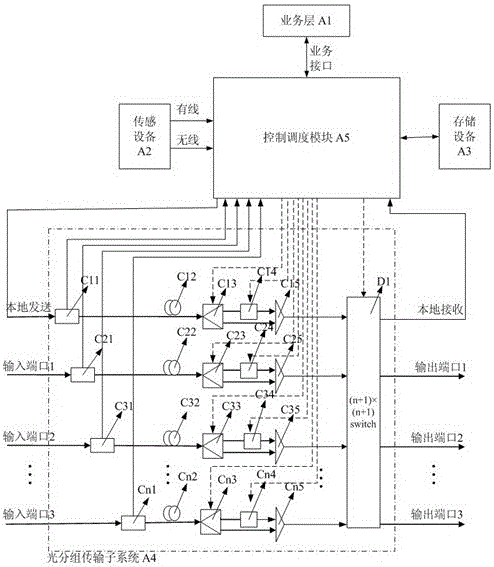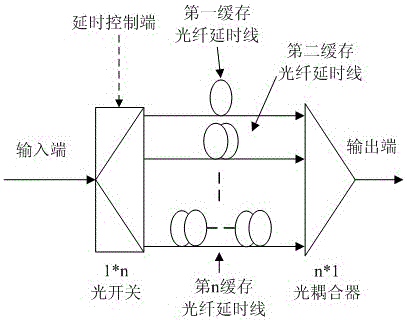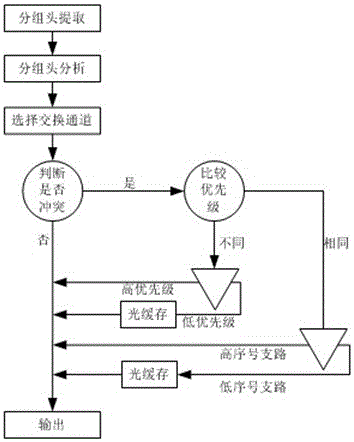A node device of a sensor network supporting sensor access and optical packet transmission
A sensor network and optical packet technology, applied in the direction of optical fiber transmission, data exchange through path configuration, etc., can solve the problem that the bit rate of signal processing cannot meet the needs of high-speed, large-capacity data interaction, etc., to increase data exchange capabilities, Flexible data exchange and the effect of providing transmission capacity
- Summary
- Abstract
- Description
- Claims
- Application Information
AI Technical Summary
Problems solved by technology
Method used
Image
Examples
Embodiment 1
[0027] A node device of a sensor network supporting sensor access and optical packet transmission, such as figure 1 shown. Including business layer A1, sensing device A2, storage device A3, optical packet transmission subsystem A4 and control scheduling module A5, business layer A1 and control scheduling module A5 are connected through service interfaces, sensing device A2 and control scheduling module A5 are connected through wired The wireless transmission interface is connected, the storage device A3 is connected with the control scheduling module A5 through the address data bus, and the optical packet transmission subsystem A4 includes n+1 switching branches, n is a positive integer not greater than 16, and (n+1 )*(n+1) gating optical switch D1, the output ends of n+1 switching branches are respectively connected to n+1 input ends of (n+1)*(n+1) gating optical switch D1, One input terminal in the n+1 switching branches is connected to the local sending port of the control...
Embodiment 2
[0036] The structure of the sensor network is as Figure 5 As shown, the optical packet transmission subsystem A4 is used to transmit and connect the nodes in the sensor network with other nodes, thereby forming a transmission network.
[0037] The sensing interface of the node device such as Figure 6 As shown, it includes XC5VLX50T FPGA chip E1, PCIE interface E2, KM62256C SRAM E3, XCF16PVO48C PROM E4, Ethernet interface E5, optical fiber interface E6, USB interface E8, ZigBee interface E9, WIFI interface E10. PCIE interface E2, KM62256C static random access memory E3, XCF16PVO48C programmable read-only memory E4, Ethernet interface E5, optical fiber interface E6, USB interface E8, ZigBee interface E9, WIFI interface E10 are respectively connected to XC5VLX50T FPGA chip E1. Among them, the PCIE interface E2 is a business interface, which is developed by the ip core of Xilinx Company. KM62256C static random access memory E3 and XCF16PVO48C programmable read-only memory E4 b...
Embodiment 3
[0041] Conflict resolution algorithm for output signals of node devices, such as image 3 shown.
[0042] When there are six optical packet signals arriving from the input ports of the first switching branch to the sixth switching branch at the same time, the priorities of the optical packet signals from the first switching branch to the sixth switching branch are respectively 2, 1, 2, 2, 3, 4, wherein the optical packet signal of the first switching branch should reach the output port 1, and the remaining optical packet signals should reach the output port 2, then the optical packet signal of the first switching branch has no conflict and can be directly output to the target port.
[0043] The optical packet signals of the second to sixth switching branches conflict, and the control scheduling module controls the 1*2 optical switch of the sixth switching branch, so that the high-priority optical packet signals of the sixth switching branch with a priority of 4 are directly ...
PUM
 Login to View More
Login to View More Abstract
Description
Claims
Application Information
 Login to View More
Login to View More - R&D Engineer
- R&D Manager
- IP Professional
- Industry Leading Data Capabilities
- Powerful AI technology
- Patent DNA Extraction
Browse by: Latest US Patents, China's latest patents, Technical Efficacy Thesaurus, Application Domain, Technology Topic, Popular Technical Reports.
© 2024 PatSnap. All rights reserved.Legal|Privacy policy|Modern Slavery Act Transparency Statement|Sitemap|About US| Contact US: help@patsnap.com










